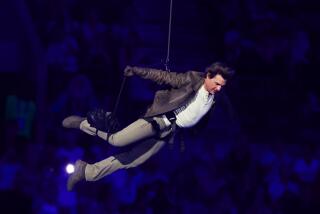BOOK REVIEW : What It Took to Put Man on the Moon : ANGLE OF ATTACK: Harrison Storms and the Race to the Moon <i> by Mike Gray</i> , W. W. Norton & Co. $22.95; 304 pages
Most books about the American space program focus on the astronauts, which is not surprising since, as NASA learned long ago, people are more interested in people than in machinery. Or, as Henry Luce taught us, names make news.
Thus, the space agency continues to emphasize the space shuttle and its astronauts, even though unmanned rockets, satellites and spacecraft could accomplish at least as much as the shuttle does at much less cost.
Those who remember the Mercury, Gemini and Apollo programs of the 1960s and America’s race to the moon can recall the great national heroes that astronauts were back then. We hung on their life stories and on their every word, though, truth to tell, they never had much to say. Nowadays, by contrast, who can remember the name of even one astronaut, much less anything about him or her? Sic transit gloria mundi .
But the attention to the astronauts in the ‘60s has generally overshadowed the real achievement of the American moon program: the staggering, breathtaking rocket and spaceship that carried the astronauts to the moon and back and the audacious engineering project that built them. There has never been anything like it. Not the building of the pyramids or the Panama Canal or the atomic bomb.
The Apollo spacecraft alone took 500 million man-hours of work, most of which, by the way, was done in Downey by the prime contractor, North American Aviation. In an age when rock stars are called awesome, what word can possibly describe this machine?
As Mike Gray writes in “Angle of Attack,” the story of the technology of the moon program: “The Apollo spacecraft contained two million functioning parts. They had to operate in a weightless void where the temperature spread between sunlight and shadow was 600 degrees. Absolutely everything had to be worked out from scratch.”
But Gray’s book is not a dry treatise full of shoptalk. Not at all. It is about people--the people who made Apollo happen. As Tom Wolfe’s “The Right Stuff” was the story of the astronauts, “Angle of Attack” is the story of the engineers, which is no less compelling, even though their names are unfamiliar. It is a very human story.
In particular, Gray focuses on Harrison Storms, North American’s swashbuckling chief engineer, who by sheer force of energy captured the contracts to build both the Apollo spacecraft and the second stage of the Saturn 5 rocket that hurtled it from Florida to the moon. To do this, he overcame North American’s initial disinterest and long head starts by competing aviation companies.
All of the physics necessary to send people to the moon was worked out by Isaac Newton three centuries ago. Actually doing it, however, was a problem in technology. Once President John Kennedy decided that the Cold War demanded that the United States be first to put a man on the moon, it fell to the engineers to do it. In Gray’s view, Harrison Storms did more than anyone else to make the lunar landing a reality in July of 1969.
But politics was never far from engineering, and Storms became a prophet without honor. In the end, after the disastrous fire on the launch pad in 1967, in which three astronauts died, North American took the blame, and Storms was forced out.
In Gray’s telling, Storms had actually argued against an all- oxygen environment in the spacecraft precisely because of the danger of fire. But he had been overruled by NASA and in particular by Gus Grissom, one of the astronauts who would die in the blaze. “Gus Grissom assisted in the alignment of the details that would seal his fate,” Gray writes.
After the fire, Gray implies that North American voluntarily agreed to take the blame in order to earn the gratitude of its big customer, NASA. Then heads had to roll, and Storms’ head was first.
When Apollo 11 lifted off for the moon, Storms was not invited to attend. He went on a friend’s chartered boat and watched from the Banana River near Cape Canaveral, then flew home to Palos Verdes to watch the rest on television along with half of the world. Like Moses, he didn’t get to set foot in the Promised Land.
“Angle of Attack” adds important information to our understanding of how the United States got to the moon. At the same time, it enhances our understanding of a world that most people take for granted, and it shows that the engineers among us are ruled by the same passions and foibles, enjoy the same pleasures and suffer the same disappointments as everyone else in the human comedy.
No matter how much I read about the space program, it remains a gripping story. As Gray writes at the very beginning of his book:
“Centuries from now, when the Cold War is as remote as the War of the Roses and the passions of our time have faded into footnotes, humanity will still remember July 16, 1969, the day the first human beings departed from Earth bound for a landing on the moon.”
More to Read
Sign up for our Book Club newsletter
Get the latest news, events and more from the Los Angeles Times Book Club, and help us get L.A. reading and talking.
You may occasionally receive promotional content from the Los Angeles Times.







